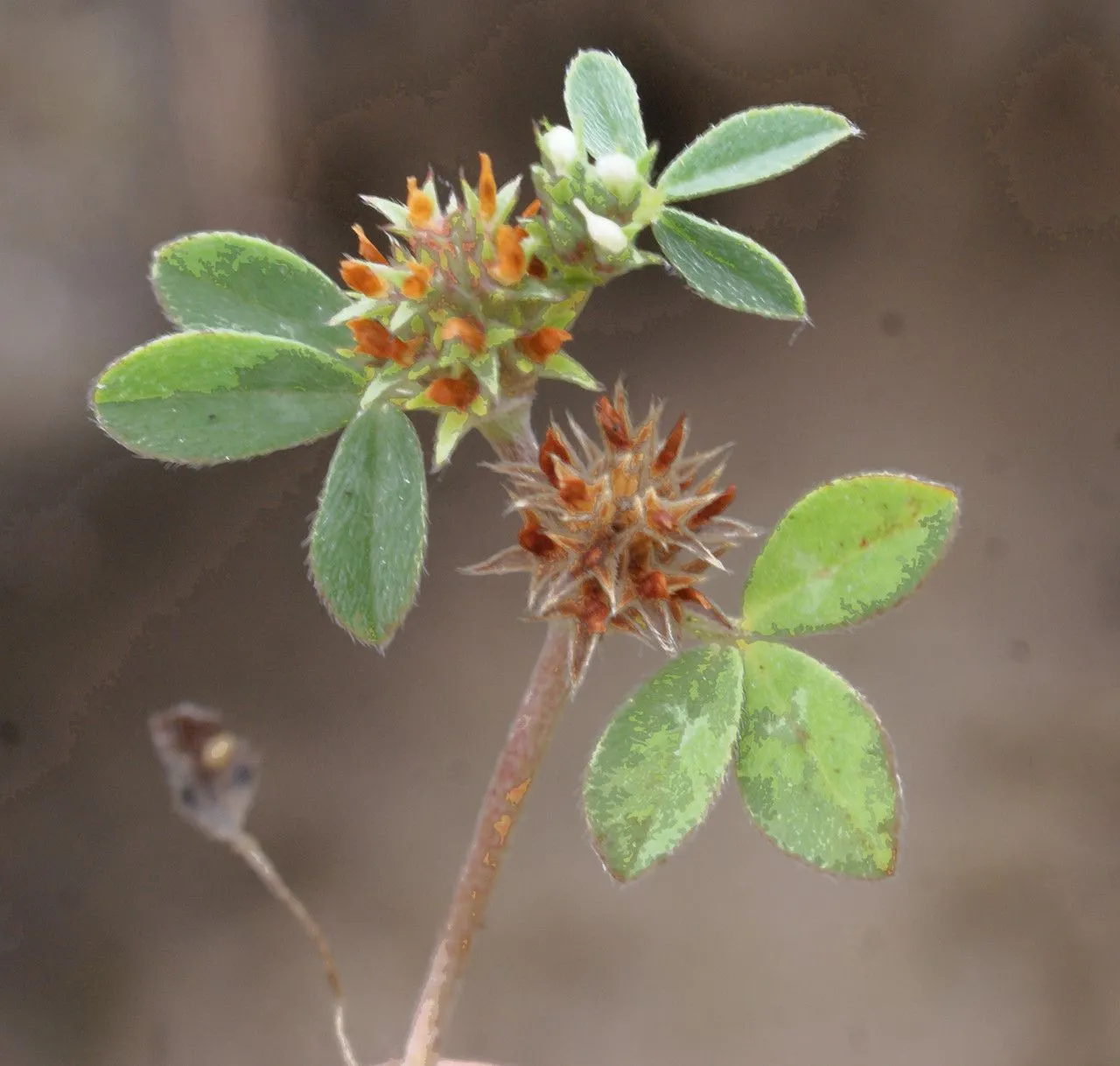
Author: L.
Bibliography: Sp. Pl.: 770 (1753)
Year: 1753
Status: accepted
Rank: species
Genus: Trifolium
Vegetable: False
Observations: Europe to Caucasus, Macaronesia to Iran
Striate clover, scientifically known as Trifolium striatum, is a fascinating plant hailing from the rich biodiversity of Europe extending to the Caucasus, and Macaronesia through to Iran. First documented in 1753, the plant was authoritatively catalogued by L., a renowned botanist of the era.
Belonging to the Fabaceae family, striate clover is part of a group of plants commonly referred to as legumes. This family is notable for its symbiotic relationship with nitrogen-fixing bacteria, which makes it particularly valuable in both natural ecosystems and agricultural settings. Known for their role in improving soil fertility, members of the Fabaceae family, including Trifolium striatum, contribute significantly to sustainable agricultural practices.
Striate clover typically flourishes in a variety of environments, adapting well across the extensive range extending from the temperate zones of Europe to the more arid regions near Iran. This adaptability highlights the plant’s resilience and versatility, making it an important species for both ecological studies and practical applications.
The morphology of Trifolium striatum is characterized by its unique striated pattern on the leaves, from which it derives its common name. These distinct markings not only make the plant easily identifiable but also add to its aesthetic appeal in both wild landscapes and cultivated gardens. The flowers of striate clover are small yet vibrant, attracting various pollinators and supporting local biodiversity.
In its native and introduced habitats, striate clover plays an essential ecological role. It serves as a food source for various insects and animals, and its growth habit helps stabilize soil, preventing erosion. Furthermore, due to its nitrogen-fixing ability, striate clover enhances soil health, promoting the growth of surrounding plants and contributing to the overall balance of the ecosystem.
Scientific interest in Trifolium striatum continues to grow, particularly in the fields of botany and environmental science. Researchers value the plant for its contribution to biodiversity and its potential applications in sustainable agriculture and ecological restoration projects.
In summary, Trifolium striatum, or striate clover, is a species of significant ecological and agricultural importance. Its extensive native range, distinctive morphology, and valuable role within the Fabaceae family make it a subject of continued interest and study in botanical and environmental sciences.
Deu: gestreifter klee
Eng: knotted clover, striate clover, soft clover
Dan: stribet kløver
Nld: gestreepte klaver
Fin: juova-apila
Swe: juova-apila, strimklöver
Nno: stripekløver
Nob: stripekløver
Lav: svītrainais
Fra: trèfle strié
Cat: trèvol estriat
Cym: meillionen rychog
Gla: seamair stríocach
Kat: სამყურა
En: Striate clover, Knotted clover, Soft Clover, Striated Clover
Bg: Жилеста детелина
Ca: Trèvol estriat
Cs: Jetel žíhaný
Da: Stribet Kløver
Nl: Gestreepte klaver
Fi: Juova-apila
Fr: Trèfle strié
Ka: Სამყურა
De: Gestreifter Klee, Streifen-Klee
Hu: Sávos here
Is: Hnútasmári
It: Trifoglio, Trifoglio striato
Lv: Svītrainais
Nb: Stripekløver
Nn: Stripekløver
Fa: شبدر رگهدار
Pl: Koniczyna kreskowana
Pt-br: Trevo-estriado
Gd: Seamair stríocach
Sv: Strimklöver, Juova-apila
Cy: Meillionen rychog
Taken May 22, 2020 by louie mer (cc-by-sa)
Taken Jun 8, 2021 by M. capitale (cc-by-sa)
Taken Sep 16, 2021 by Vectis Nunsuch (cc-by-sa)
Taken Jul 22, 2010 by Tela Botanica − Yoan MARTIN (cc-by-sa)
Taken May 18, 2019 by Lopez (cc-by-sa)
Taken Jun 23, 2016 by Tela Botanica − Liliane ROUBAUDI (cc-by-sa)
Taken Jun 23, 2016 by Tela Botanica − Liliane ROUBAUDI (cc-by-sa)
Taken Jun 23, 2016 by Tela Botanica − Liliane ROUBAUDI (cc-by-sa)
Taken Jun 23, 2016 by Tela Botanica − Liliane ROUBAUDI (cc-by-sa)
Taken Jul 16, 2010 by Tela Botanica − Yoan MARTIN (cc-by-sa)
Taken Jan 1, 1900 by EOL − Encyclopedia of Life (cc-by-nc-sa)
Taken Jan 1, 1900 by EOL − Encyclopedia of Life (cc-by-nc-sa)
Taken Jun 30, 2012 by Tela Botanica − Marie PORTAS (cc-by-sa)
Taken Jun 17, 2016 by Tela Botanica − Emmanuel STRATMAINS (cc-by-sa)
Taken Jun 17, 2016 by Tela Botanica − Emmanuel STRATMAINS (cc-by-sa)
Taken Jun 23, 2016 by Tela Botanica − Liliane ROUBAUDI (cc-by-sa)
Taken Jun 23, 2016 by Tela Botanica − Liliane ROUBAUDI (cc-by-sa)
Taken Jul 16, 2010 by Tela Botanica − Yoan MARTIN (cc-by-sa)
Taken Jul 22, 2010 by Tela Botanica − Yoan MARTIN (cc-by-sa)
Taken Jun 14, 2022 by Pierre Michel Lamonzie (cc-by-sa)
Taken Apr 14, 2017 by Pedro Salgadinho (cc-by-sa)
Taken Jan 1, 1900 by EOL − Encyclopedia of Life (cc-by-nc-sa)
Taken Jul 19, 2012 by Tela Botanica − Yoan MARTIN (cc-by-sa)
Taken May 31, 1852 by Tela Botanica − Herbier PONTARLIER-MARICHAL (cc-by-sa)
Taken Jan 1, 1970 by Photoflora – L’Abbé COSTE (©)
Taken Jan 1, 1900 by EOL − Encyclopedia of Life (cc-by-nc-sa)
© copyright of the Board of Trustees of the Royal Botanic Gardens, Kew.
Growth habit: Forb/herb
Bloom months: [‘may’, ‘jun’, ‘jul’]
Family: Myrtaceae Author: (F.Muell.) K.D.Hill & L.A.S.Johnson Bibliography: Telopea 6: 402 (1995) Year: 1995 Status:…
Family: Rubiaceae Author: Pierre ex A.Froehner Bibliography: Notizbl. Bot. Gart. Berlin-Dahlem 1: 237 (1897) Year:…
Family: Sapindaceae Author: Koidz. Bibliography: J. Coll. Sci. Imp. Univ. Tokyo 32(1): 38 (1911) Year:…
Family: Asteraceae Author: A.Gray Bibliography: Pacif. Railr. Rep.: 107 (1857) Year: 1857 Status: accepted Rank:…
Family: Fabaceae Author: Medik. Bibliography: Vorles. Churpfälz. Phys.-Ökon. Ges. 2: 398 (1787) Year: 1787 Status:…
Family: Aspleniaceae Author: (Cav.) Alston Bibliography: Bull. Misc. Inform. Kew 1932: 309 (1932) Year: 1932…